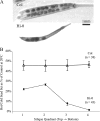Temperature stress and plant sexual reproduction: uncovering the weakest links
- PMID: 20351019
- PMCID: PMC2917059
- DOI: 10.1093/jxb/erq053
Temperature stress and plant sexual reproduction: uncovering the weakest links
Abstract
The reproductive (gametophytic) phase in flowering plants is often highly sensitive to hot or cold temperature stresses, with even a single hot day or cold night sometimes being fatal to reproductive success. This review describes studies of temperature stress on several crop plants, which suggest that pollen development and fertilization may often be the most sensitive reproductive stage. Transcriptome and proteomic studies on several plant species are beginning to identify stress response pathways that function during pollen development. An example is provided here of genotypic differences in the reproductive stress tolerance between two ecotypes of Arabidopsis thaliana Columbia (Col) and Hilversum (Hi-0), when reproducing under conditions of hot days and cold nights. Hi-0 exhibited a more severe reduction in seed set, correlated with a reduction in pollen tube growth potential and tropism defects. Hi-0 thus provides an Arabidopsis model to investigate strategies for improved stress tolerance in pollen. Understanding how different plants cope with stress during reproductive development offers the potential to identify genetic traits that could be manipulated to improve temperature tolerance in selected crop species being cultivated in marginal climates.
Figures



Similar articles
-
A comparison of heat-stress transcriptome changes between wild-type Arabidopsis pollen and a heat-sensitive mutant harboring a knockout of cyclic nucleotide-gated cation channel 16 (cngc16).BMC Genomics. 2018 Jul 24;19(1):549. doi: 10.1186/s12864-018-4930-4. BMC Genomics. 2018. PMID: 30041596 Free PMC article.
-
Pollen development at high temperature and role of carbon and nitrogen metabolites.Plant Cell Environ. 2019 Oct;42(10):2759-2775. doi: 10.1111/pce.13576. Epub 2019 Jun 19. Plant Cell Environ. 2019. PMID: 31077385 Review.
-
A cyclic nucleotide-gated channel (CNGC16) in pollen is critical for stress tolerance in pollen reproductive development.Plant Physiol. 2013 Feb;161(2):1010-20. doi: 10.1104/pp.112.206888. Epub 2012 Dec 12. Plant Physiol. 2013. PMID: 23370720 Free PMC article.
-
Loss of the Arabidopsis thaliana P₄-ATPase ALA3 reduces adaptability to temperature stresses and impairs vegetative, pollen, and ovule development.PLoS One. 2013 May 7;8(5):e62577. doi: 10.1371/journal.pone.0062577. Print 2013. PLoS One. 2013. PMID: 23667493 Free PMC article.
-
High temperature susceptibility of sexual reproduction in crop plants.J Exp Bot. 2020 Jan 7;71(2):555-568. doi: 10.1093/jxb/erz426. J Exp Bot. 2020. PMID: 31560053 Review.
Cited by
-
Aromatic components and endophytic fungi during the formation of agarwood in Aquilaria sinensis were induced by exogenous substances.Front Microbiol. 2024 Aug 21;15:1446583. doi: 10.3389/fmicb.2024.1446583. eCollection 2024. Front Microbiol. 2024. PMID: 39234541 Free PMC article.
-
Floral transcriptomes reveal gene networks in pineapple floral growth and fruit development.Commun Biol. 2020 Sep 10;3(1):500. doi: 10.1038/s42003-020-01235-2. Commun Biol. 2020. PMID: 32913289 Free PMC article.
-
The elucidation of stress memory inheritance in Brassica rapa plants.Front Plant Sci. 2015 Jan 21;6:5. doi: 10.3389/fpls.2015.00005. eCollection 2015. Front Plant Sci. 2015. PMID: 25653665 Free PMC article.
-
The thermal environment at fertilization mediates adaptive potential in the sea.Evol Lett. 2021 Feb 23;5(2):154-163. doi: 10.1002/evl3.215. eCollection 2021 Apr. Evol Lett. 2021. PMID: 33868711 Free PMC article.
-
Acclimation to high temperature during pollen development.Plant Reprod. 2016 Jun;29(1-2):107-18. doi: 10.1007/s00497-016-0282-x. Epub 2016 Apr 11. Plant Reprod. 2016. PMID: 27067439 Free PMC article. Review.
References
-
- Allen DJ, Ort DR. Impacts of chilling temperatures on photosynthesis in warm-climate plants. Trends in Plant Science. 2001;6:36–42. - PubMed
-
- Aloni B, Peet M, Pharr M, Karni L. The effect of high temperature and high atmospheric CO2 on carbohydrate changes in bell pepper (Capsicum annuum) pollen in relation to its germination. Physiologia Plantarum. 2001;112:505–512. - PubMed
-
- Apel K, Hirt H. Reactive oxygen species: metabolism, oxidative stress, and signal transduction. Annual Review of Plant Biology. 2004;55:373–399. - PubMed
-
- Baniwal SK, Bharti K, Chan KY, et al. Heat stress response in plants: a complex game with chaperones and more than twenty heat stress transcription factors. Journal of Biosciences. 2004;29:471–487. - PubMed
Publication types
MeSH terms
Grants and funding
LinkOut - more resources
Full Text Sources
Other Literature Sources

